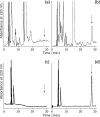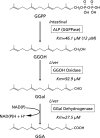Polished rice as natural sources of cancer-preventing geranylgeranoic acid
- PMID: 21765600
- PMCID: PMC3128369
- DOI: 10.3164/jcbn.10-110
Polished rice as natural sources of cancer-preventing geranylgeranoic acid
Abstract
Geranylgeranoic acid, a 20-carbon polyprenoic acid (all-trans 3,7,11,15-tetramethyl-2,4,6,10,14-hexadecatetraenoic acid) and its derivatives were previously developed as synthetic "acyclic retinoids" for cancer chemoprevention. Recently, we demonstrated the natural occurrence of geranylgeranoic acid in various medicinal herbs (Shidoji and Ogawa, 2004). In this present study, we present several lines of evidence to demonstrate that geranylgeranyl diphosphate taken in foods could be metabolized to GGA through geranylgeraniol and geranylgeranyl aldehyde via the following steps: 1) The conversion from geranylgeranyl diphosphate to geranylgeraniol was demonstrated to occur by the action of bovine intestinal alkaline phosphatase, with a K(m) of 46.1 µM. 2) Geranylgeraniol oxidase-mediated conversion of geranylgeraniol to geranylgeranyl aldehyde was revealed in rat liver homogenates, which activity was mainly localized in the mitochondrial fraction. The mitochondrial enzyme showed a K(m) of 92.9 µM. 3) The conversion of geranylgeranyl aldehyde to geranylgeranoic acid by geranylgeranyl aldehyde dehydrogenase in rat liver homogenates was absolutely dependent on exogenously added NAD(+) or NADP(+). The K(m) of the mitochondrial geranylgeranyl aldehyde dehydrogenase was 27.5 µM for geranylgeranyl aldehyde. Taken together, our data suggest that cancer preventive geranylgeranoic acid could be a physiological metabolite from commonly consumed foods.
Keywords: cancer chemoprevention; geranylgeraniol; geranylgeranoic acid; geranylgeranyl diphosphate; polished rice.
Figures




Similar articles
-
Geranylgeraniol oxidase activity involved in oxidative formation of geranylgeranoic acid in human hepatoma cells.Biomed Res. 2012 Feb;33(1):15-24. doi: 10.2220/biomedres.33.15. Biomed Res. 2012. PMID: 22361882
-
Increase in plasma concentrations of geranylgeranoic Acid after turmeric tablet intake by healthy volunteers.J Clin Biochem Nutr. 2010 May;46(3):252-8. doi: 10.3164/jcbn.09-109. Epub 2010 Apr 10. J Clin Biochem Nutr. 2010. PMID: 20490321 Free PMC article.
-
Natural occurrence of cancer-preventive geranylgeranoic acid in medicinal herbs.J Lipid Res. 2004 Jun;45(6):1092-103. doi: 10.1194/jlr.M300502-JLR200. Epub 2004 Apr 1. J Lipid Res. 2004. PMID: 15060084
-
Geranylgeranoic acid, a bioactive and endogenous fatty acid in mammals: a review.J Lipid Res. 2023 Jul;64(7):100396. doi: 10.1016/j.jlr.2023.100396. Epub 2023 May 27. J Lipid Res. 2023. PMID: 37247782 Free PMC article. Review.
-
Phytol metabolism in plants.Prog Lipid Res. 2019 Apr;74:1-17. doi: 10.1016/j.plipres.2019.01.002. Epub 2019 Jan 7. Prog Lipid Res. 2019. PMID: 30629961 Review.
Cited by
-
Oral Administration of Geranylgeraniol Rescues Denervation-induced Muscle Atrophy via Suppression of Atrogin-1.In Vivo. 2020 Sep-Oct;34(5):2345-2351. doi: 10.21873/invivo.12047. In Vivo. 2020. PMID: 32871759 Free PMC article.
-
Dietary geranylgeraniol can limit the activity of pitavastatin as a potential treatment for drug-resistant ovarian cancer.Sci Rep. 2017 Jul 14;7(1):5410. doi: 10.1038/s41598-017-05595-4. Sci Rep. 2017. PMID: 28710496 Free PMC article.
-
Effect of Dietary Geranylgeraniol and Green Tea Polyphenols on Glucose Homeostasis, Bone Turnover Biomarkers, and Bone Microstructure in Obese Mice.Int J Mol Sci. 2023 Jan 4;24(2):979. doi: 10.3390/ijms24020979. Int J Mol Sci. 2023. PMID: 36674494 Free PMC article.
-
Geranylgeraniol Inhibits Lipopolysaccharide-Induced Inflammation in Mouse-Derived MG6 Microglial Cells via NF-κB Signaling Modulation.Int J Mol Sci. 2021 Sep 29;22(19):10543. doi: 10.3390/ijms221910543. Int J Mol Sci. 2021. PMID: 34638882 Free PMC article.
-
Unequivocal evidence for endogenous geranylgeranoic acid biosynthesized from mevalonate in mammalian cells.J Lipid Res. 2019 Mar;60(3):579-593. doi: 10.1194/jlr.M090548. Epub 2019 Jan 8. J Lipid Res. 2019. PMID: 30622150 Free PMC article.
References
-
- Muto Y, Moriwaki H, Omori M. In vitro binding affinity of novel synthetic polyprenoids (polyprenoic acids) to cellular retinoid-binding proteins. Gann. 1981;72:974–977. - PubMed
-
- Araki H, Shidoji Y, Yamada Y, Moriwaki H, Muto Y. Retinoid agonist activities of synthetic geranyl geranoic acid derivatives. Biochem Biophys Res Commun. 1995;209:66–72. - PubMed
-
- Yamada Y, Shidoji Y, Fukutomi Y, et al. Positive and negative regulations of albumin gene expression by retinoids in human hepatoma cell lines. Mol Carcinog. 1994;10:151–158. - PubMed
-
- Muto Y, Moriwaki H. Antitumor activity of vitamin A and its derivatives. J Natl Cancer Inst. 1984;73:1389–1393. - PubMed

